
Warning: This journal entry is written from by a fangirl. There may be gushing, drooling and eye-twinkling laced throughout the story.
Princesses, castles, knights and ballrooms. Golden mirrors, tall ceilings, rococo everywhere you look.
If people could see my daydreams, I might be viewed as six years old. I'm still stuck in the days of a monarchistic world. Only, my imagination tends to make it a bit more romantic than what it probably was. My head is flooding with Kings, Emperors and their noble advisors. I think about how life must have been back in the days of a Monarch. Scary and admirable at the same time.
Moving to Germany didn't help me with my childlike dreams. During the years that we vacationed in Germany, I tried to persuade my family into viewing King Ludwig II's castles. Over the course of 6 years, nearly every palace was checked from my list. Not just the ones he built, but the ones which he and his family resided in. All except one.
Schloss Nymphenburg.
When you're standing in front of the 700 meters of elegance, it's hard not to lose yourself to the impeccable taste of Bavarian rulers. They certainly knew what they were doing when it came to building... despite the enormous expenses and debts that encircled the constructions.
No matter!
Today, Germany is a prosperous economy and we can enjoy the summer palace without a trot.
Schloss Nymphenburg was used mainly as a summer residence for the rulers of Bavaria after its construction. Elector Ferdinand Maria built Nymphenburg for his wife, Henriette Adelaide of Savoy, as a thank you note for the birth of a son.
I wonder if he grew up to be spoiled (I'm rolling my eyes, if you can't tell).
The castle began construction in 1664 and thankful remains today. Over the next hundred of years, Bavarian rulers expanded the magnificent palace and its grounds.
I won't lie. Many people told me that Nymphenburg was somewhat of a disappointment.
"It wasn't as grand as other castles."
"There wasn't much to see."
"If you're only in Munich for a couple of days, don't waste your time."
Oh, but how wrong they were.
Schloss Nymphenburg's 10 Best Sights
Though the main castle only allows you to see one floor, do not feel cheated out of your money. Behind the castle is where the true magnificence lies, so make sure that you buy a pass to see all of the grounds. It costs 11 euros for anyone over 18 and free for those under.
Don't miss that deal!
Now onto the fun stuff. I'm going to toss out my opinion of the top 10 sights at Schloss Nymphenburg. Hopefully, I won't only excite you, but persuade you to make a day of this spectacular place.
Oh, and another quick tip: BRING YOUR CAMERA! Nymphenburg lets you take photos everywhere (just make sure you turn off that flash!).
10. Badenburg
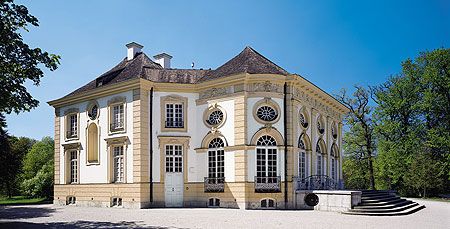
Quick german lesson!
Bad = Bathroom/Bath
So, Badenburg is what we know as a bathhouse. Badenburg is located towards the back of the park grounds and awaits you with it's traditional charm. Don't worry! It's no more than a four minute walk and signs will easily guide you in the right direction. The wooded stroll is also extremely relaxing; you won't feel rushed to get to your next destination.
When you first enter Badenburg, the main hall is certainly a sight to see. It takes up two stories and surrounds you in the traditional rococo feel. The next three rooms are completely different, so get ready!
All three rooms are shouded in Chinese wallpaper. One of them is the oldest Chinese wallpaper in the world! Another section is dubbed the "monkey room". Take a look at the ceiling if you're wondering why. I won't give any spoiler pictures.
And of course, what is a bathhouse without a bath? An enormous bath, on that note! As you stand over the balcony and look down into the tub, can you imagine all of the wild parties they must have had? I can't help but view it as its own room!
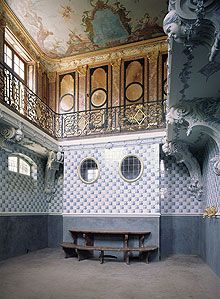
Anyone care for a bath?
But, more important than the bath itself is the marble balcony. I think they wanted to kick me out. I was gawking for far too long.
9. Magdelenenklause (Hermitage)

"What is that old building doing on the palace park?"
The small building tucked away sneakily in the woods was purposely built to look like a crumbling hermitage. It exists to teach us a lesson:
There is frailty in all things earthly.
The building was created in 1725 in order to "escape from reality" and find spiritual awakening.
As you enter the deserted building, the first thing you'll want to do is make your way to the alter niche. Hold on! Make sure that you look up before anything else. The ceiling is decorated completely in seashells and stones. I trust you won't have a hard time missing it.


L to R: A view of the spiritual room. Part of the alter niche.
As you make your way down the dim halls, the rooms seem to hug you with their beautiful, oak panelling. Though they make for marvelous photos, I couldn't help but feel a tad frightened. The whole building was eerily quiet. No one seemed to notice that it was there. When the light flickered through the tree branches it was almost like the shadow of Max Emanuel led us through the halls.
This is certainly a stop you'll want to make. Even if it does send a shiver down your spine.
8. King Ludwig II's Birth Room

Here's where the fangirl comes in. I couldn't help but be awed by the lucious, emerald room where King Ludwig II was brought into this world. Supposedly born on August 25th, 1845, mystery surrounded Ludwig his entire life from the day he was born.
Ludwig Wittelsbach II was named after his grandfather, who was also born on the 25th of August. Many people believe that the prince was actually born three days earlier, but the family kept it a secret in order to form a stronger connection between the shared name.
It does seem to be a slim chance that he happened to be born on the same day. However, speculation passed quickly as the country fell in love with the beautiful heir.
It was only when he became king in 1865 that they began to have their doubts.
Read more about my favourite historical figure here:
Short Biography
Timeline of Important Days
7. Apollo Temple

Sorry, but you're not going to see the giant Greek ruin here. The Apolo Temple at Nympheburg is still charming in its own way.
I don't know what it is with me and temples, but I've always had a fascination with them. I blame it on the heart-breaking scene in 2005's Pride and Prejudice.

"From the first moment I met you, your arrogance and conceit, your selfish disdain for the feelings of others made me realize that you were the last man in the world I could ever be prevailed upon to marry."
My reaction:

Anyway.
My mother and I didn't find a way to get there, nor did we have the time. If you do have time, try and find the path. Situated perfectly on the shore, the Apolo Temple's view of the sunset will certainly take your breath away.
Skip it if you're on a time crunch. You can easily spot the temple from Badenburg.
6. Pagodenburg

Many people were shoved out for not having tickets here, so make sure that yours has Pagodenburg on the check-off list.
This building is certainly the furthest out, but it is absolutely worth the walk. If you tired halfway though, stop for a minute and feed the ducks. They'll apprecaite it.
Pagodenburg sits on the edge of the main canal. The royals used to play "mailspiel" here, a game similar to golf.
Inside, you might want to instantly scream, "Delft!". But, hold on. When you take a closer look at the blue and white walls, hundreds of Chinese men will be the ones to stare back at you. Not quite as lovely as a Holland village.
The uniqueness of the 4-roomed palace is certainly evident. The porcelain wall designs take you on a blast to the past. Nymphenburg was a huge porcelain manufacturer in the 1700s.
My mother and I were so excited by the ground floor that we were certain that was all there was. Think again! A small staircase will lead you to more Oriental treasures.
On the right is anyone's dream lounge. A green day bed comes complete with a canopy to block out your noisy relatives. The fireplace is perfect to cuddle up next to with a good book. I don't know about you, but that is my paradise.

On the left is what appears to be a tea room. It's amber walls flash white flowers in your face that are certain to make your eyes twinkle. For a moment, I forgot that I was in Germany.
5. King Ludwig I's Gallery of Beauties

This was my favorite room in all of the buildings. The Schönheit (beauty) Gallery took me utterly by surprise.
Ranging from a shoemaker's daughter, to Ludwig I's daughter-in-law, the Gallery of Beauties defies the classes of society. Ludwig I was determined to start a collection of beautiful female portraits, regardless of their income.
Every picture was perfectly chosen. Ludwig I clearly had a great taste in women. You can only imagine all of the mistresses he had. As you look into each of their eyes, each woman's story invites you in. There are dancers, princesses, paupers and rebels: all of them resided in Munich.


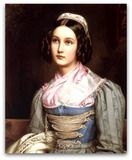
From L to R: Marie, Ludwig I's daughter-in-law. Lola Montez, dancer and actress. She later became Ludwig I's mistress. The puplic strongly disliked her for her arrogant manners. Helene Sedelmayer, daughter of a shoemaker. She brought toys to Ludwig's children and married his valet.
There are many more beauties that you can read about here:
History of the beauties
4. The Great Hall
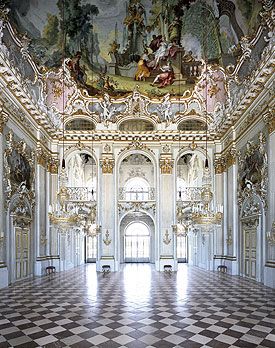
Anyone care for a turn about the room?
This is the first thing you will see on your tour of the Nymphenburg Palace. Though the tour is only of one floor, you will see an array of treasures. The Grand Hall is by far the most magnificent room, and what most tourists long to see when it comes to palaces.
This room has not been changed since 1758. There's the exception of polishing up, and some daydreams floating around the air.
3. The Front Facade
This palace is huge. It stretches out far past your view point. It's no Versailles, but taking some photographs in the front will certainly make your family members smile when they check their emails.
There is a pond and a canal in front of the castle, each flooding with ducks and swans (the Wittelsbach royal animal). Make sure you get some photos with them! They love the attention.
2. Marstallmuseum

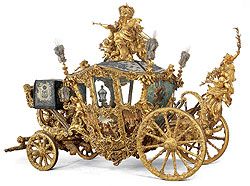
Carriage of King Ludwig II
Okay.
Where do I start?
The Martstallmuseum holds an enormous amount of carriages and sleighs from the 18 and 19th centuries. You can see anything from a musician's cart to the enormous coaches built specifically for Ludwig II. Each one is sure to impress, but nothing is as astounding as the Mad King's collection.
There are also 26 paintings of Ludwig's favourite horses. Throughout the room you can find famous portraits and photos of the King and his relatives. For the art lovers, a porcelain museum awaits you upstairs. Don't forget to take a glance at one of the oldest carousels!
Being a fangirl, I was thrilled to see wedding lace from Duchess Sophie's unused veil. It was a bit heart-breaking, but certainly a treat.

King Ludwig II and Duchess Sophie: The couple that never was
Be sure to check out Ludwig II's favourite horse. "Didn't he die in 1886?" Well, yes. The horse has been stuffed and stands as proudly as he did when Ludwig rode him. If you get close enough, you can see the stitches where he was... Well, you know.
1. Amalienburg
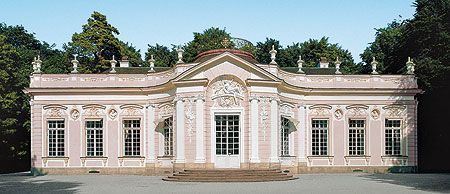
Finally! We've come to the end of our tour.
A small palace and hunting lodge built for Maria Amalia, this building is clearly a perfect hideaway. Though it may look like another mini palace from the outside, and even on the inside, you must take a closer look at everything to see the true beauty of the place.
If you're instantly expecting glamor, don't get your hopes up. The first room is built with simple wood panals and designs. It's different, but let's keep walking.
Making your way into the following rooms is where the true gasping begins. The colourful walls are completely decorated in silver rococo decorations. But, is it just another day at the palace? Underneath very silver twist and turn is actually carved wood! The carvings are a truly rare as it was time-consuming and a difficult process.

All of that silver stuff is wood.
Take a second.
Take it allll in.
The Hall of Mirrors has the exact same jaw-dropping effect, but echoes a bit of Versailles or Herrenchiemsee. The unique, circular shape of the hall is a pleasant surprise and can easily be listed as my favorite room in the hut.
Next up is the hunting room, easily recognized by the hunting scenes on the walls. Perhaps it was encouragement for the Queen to get active on her lazy days.
And finally, the kitchen. I'm assuming the Queen didn't cook for herself, but if I were her, I would want to sit in there and at least watch. The delft Chinese tiles are back! Make sure you look at the left corner above the stove. The designers ran out of tiles, so there seem to be a few misplaced flowers hanging out.
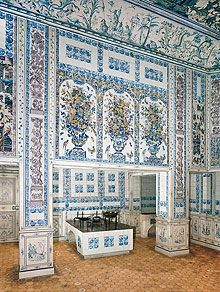
What's for dinner?
Well, dear reader, I hope I convinced you to take a trip to Nymphenburg during your future Germany visit. For those of you who have already seen the palace, I hope you can agree with me on my top 10. I'd love to know what some of your favorite sights were!
Leave a comment below and tell me all about it!
-Allie